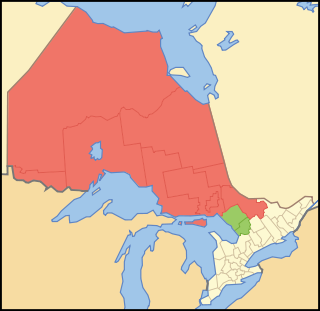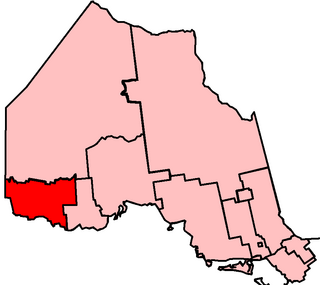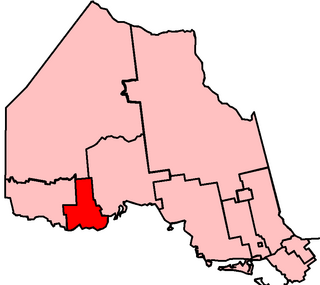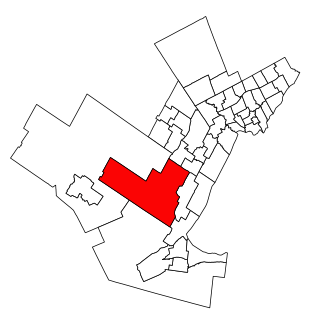Related Research Articles

Northern Ontario is a primary geographic and quasi-administrative region of the Canadian province of Ontario, the other primary region being Southern Ontario. Most of the core geographic region is located on part of the Superior Geological Province of the Canadian Shield, a vast rocky plateau located mainly north of Lake Huron, the French River, Lake Nipissing, and the Mattawa River. The statistical region extends south of the Mattawa River to include all of the District of Nipissing. The southern section of this district lies on part of the Grenville Geological Province of the Shield which occupies the transitional area between Northern and Southern Ontario. The extended federal and provincial quasi-administrative regions of Northern Ontario have their own boundaries even further south in the transitional area that vary according to their respective government policies and requirements. Ontario government departments and agencies such as the Growth Plan for Northern Ontario and the Northern Ontario Heritage Fund Corporation define Northern Ontario as all areas north of, and including, the districts of Parry Sound and Nipissing for political purposes, and the federal but not the provincial government also includes the district of Muskoka.

Howard George Hampton is a politician who was a member of Provincial Parliament for the province of Ontario. He served in the Legislative Assembly of Ontario, Canada, from 1987 to 1999 in the electoral district of Rainy River, and from 1999 to 2011 in the redistributed electoral district of Kenora—Rainy River. A member of the Ontario New Democratic Party, he was also the party's leader from 1996 to 2009. Hampton retired from the legislature at the 2011 Ontario provincial election and subsequently joined Fasken Martineau DuMoulin LLP as a member of the law firm's corporate social responsibility and aboriginal affairs groups.

An electoral district in Canada is a geographical constituency upon which Canada's representative democracy is based. It is officially known in Canadian French as a circonscription but frequently called a comté (county). In Canadian English it is also colloquially and more commonly known as a riding or constituency.
Frank Ranover Miclash is a former politician in Ontario, Canada. He served as a Liberal member of the Legislative Assembly of Ontario from 1987 to 1999.

Oshawa is a federal electoral district in Ontario, Canada, that is represented in the House of Commons of Canada. It currently consists of the City of Oshawa south of Taunton Road. Historically, the riding was dominated by a working-class electorate.

Kenora is a federal electoral district in Ontario, Canada, that has been represented in the House of Commons of Canada since 2004.
Thunder Bay and Rainy River was a federal electoral district represented in the House of Commons of Canada from 1904 to 1917. It was located in the northwestern part of the province of Ontario. This riding was created in 1903 from parts of Algoma riding.
Thunder Bay was an electoral district in the northwestern part of the province of Ontario, Canada, that was represented in the House of Commons of Canada from 1968 to 1979, and the Legislative Assembly of Ontario until 1975.
Thunder Bay—Atikokan was a federal electoral district in northwestern Ontario, Canada, that was represented in the House of Commons of Canada from 1979 to 2003 and in the Legislative Assembly of Ontario from 1999 to 2007. The federal riding was created in 1976, from parts of Fort William and Thunder Bay ridings. It became a provincial riding in 1999.

Parry Sound—Muskoka is a provincial electoral district in the Canadian province of Ontario.

Sault Ste. Marie is a provincial electoral district in the Legislative Assembly of Ontario, representing the City of Sault Ste. Marie.


Kenora—Rainy River is a provincial electoral district (riding) in northwestern Ontario, Canada, that has been represented in the Legislative Assembly of Ontario since 1999. It was created from Kenora, most of Rainy River and part of Lake Nipigon. The boundaries of the new district corresponded with the Kenora—Rainy River federal riding, until it was abolished in 2003. The provincial riding will continue to exist.
London Centre is a defunct Ontario provincial electoral district that was abolished in 1996. Its most notable representative was former Liberal Premier David Peterson, and was located in London, Ontario.

Nickel Belt is a provincial electoral district located in the Canadian province of Ontario. It elects one member to the Legislative Assembly of Ontario. The district is located in Northern Ontario and includes much of the eastern and southern parts of the District of Sudbury, as well as most of Greater Sudbury outside the city's urban core. Communities include Lively, Onaping, Levack, Dowling, Chelmsford, Naughton, Azilda, Coniston, Wahnapitae, Garson, Val Caron, Val Thérèse, Hanmer and Capreol.

Nipissing is a provincial electoral district in the Canadian province of Ontario, which elects one member to the Legislative Assembly of Ontario. It is located in the northeastern part of Ontario, centred on the city of North Bay.

Thunder Bay—Atikokan is a provincial electoral district in northwestern Ontario, Canada, that has been represented in the Legislative Assembly of Ontario since 1999.

Thunder Bay—Superior North is a provincial electoral district in Ontario, Canada, that has been represented in the Legislative Assembly of Ontario since 1999.

High Park was a provincial electoral district in the west-end of the old City of Toronto, Ontario, Canada. It was represented in the Legislative Assembly of Ontario from 1926 to 1975. It was mostly redistributed into the High Park—Swansea electoral district for the 1975 Ontario general election.

Milton is a federal electoral district in Ontario, Canada, that consists of the town of Milton and part of Burlington which has a population growing much faster than the Ontario average. It was created by the 2012 federal redistribution and previously part of Halton. Redistributed results showed that Conservative Lisa Raitt won the area easily in 2011, although her vote share dropped in the 2015 election and the Liberals took the riding in 2019. Since 2019 it has been represented by Liberal Adam van Koeverden.
References
- ↑ "FOUR NEW RIDINGS IN NEW ONTARIO: More Details of the Scheme of Redistribution". The Globe and Mail , March 21, 1908.
- ↑ "Hampton win tainted by NDP showing: Leader blames strategic voting for party's performance". National Post , June 4, 1999.
- ↑ "Ridings face 2-for-1 split as redistribution looms". The Globe and Mail , April 11, 1983.